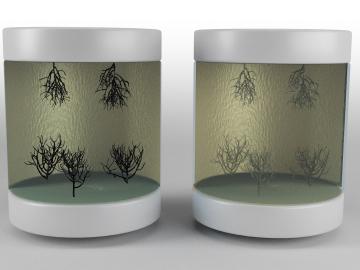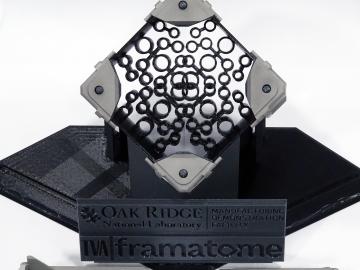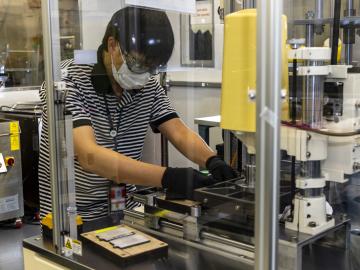
Filter News
Area of Research
- (-) Energy Science (96)
- Advanced Manufacturing (5)
- Biology and Environment (23)
- Biology and Soft Matter (1)
- Fuel Cycle Science and Technology (1)
- Fusion and Fission (28)
- Fusion Energy (12)
- Isotope Development and Production (1)
- Isotopes (3)
- Materials (38)
- Materials for Computing (6)
- National Security (7)
- Neutron Science (10)
- Nuclear Science and Technology (37)
- Nuclear Systems Modeling, Simulation and Validation (2)
- Supercomputing (11)
- Transportation Systems (2)
News Type
News Topics
- (-) Advanced Reactors (5)
- (-) Composites (16)
- (-) Molten Salt (1)
- (-) Nuclear Energy (7)
- (-) Transportation (60)
- 3-D Printing/Advanced Manufacturing (74)
- Artificial Intelligence (7)
- Big Data (2)
- Bioenergy (26)
- Biology (11)
- Biomedical (6)
- Biotechnology (4)
- Buildings (32)
- Chemical Sciences (14)
- Clean Water (8)
- Computer Science (25)
- Coronavirus (11)
- Critical Materials (8)
- Cybersecurity (8)
- Energy Storage (67)
- Environment (46)
- Exascale Computing (2)
- Fossil Energy (2)
- Frontier (1)
- Fusion (1)
- Grid (37)
- High-Performance Computing (5)
- Hydropower (3)
- Isotopes (1)
- Machine Learning (6)
- Materials (34)
- Materials Science (24)
- Mathematics (2)
- Mercury (3)
- Microelectronics (1)
- Microscopy (8)
- Nanotechnology (8)
- National Security (5)
- Neutron Science (9)
- Partnerships (12)
- Physics (1)
- Polymers (11)
- Quantum Science (2)
- Security (6)
- Simulation (3)
- Space Exploration (3)
- Statistics (1)
- Summit (4)
Media Contacts

Scientists at Oak Ridge National Laboratory successfully demonstrated a technique to heal dendrites that formed in a solid electrolyte, resolving an issue that can hamper the performance of high energy-density, solid-state batteries.

Oak Ridge National Laboratory researchers combined additive manufacturing with conventional compression molding to produce high-performance thermoplastic composites reinforced with short carbon fibers.

Xin Sun has been selected as the associate laboratory director for the Energy Science and Technology Directorate, or ESTD, at the Department of Energy’s Oak Ridge National Laboratory.

Fuel economy can take a tumble when temperatures plummet, according to the Department of Energy’s 2021 Fuel Economy Guide. Compiled by researchers at Oak Ridge National Laboratory, the guide includes several tips to improve a vehicle’s fuel performance.

Six scientists at the Department of Energy’s Oak Ridge National Laboratory were named Battelle Distinguished Inventors, in recognition of obtaining 14 or more patents during their careers at the lab.

Oak Ridge National Laboratory researchers have developed a new family of cathodes with the potential to replace the costly cobalt-based cathodes typically found in today’s lithium-ion batteries that power electric vehicles and consumer electronics.

If air taxis become a viable mode of transportation, Oak Ridge National Laboratory researchers have estimated they could reduce fuel consumption significantly while alleviating traffic congestion.

As ORNL’s fuel properties technical lead for the U.S. Department of Energy’s Co-Optimization of Fuel and Engines, or Co-Optima, initiative, Jim Szybist has been on a quest for the past few years to identify the most significant indicators for predicting how a fuel will perform in engines designed for light-duty vehicles such as passenger cars and pickup trucks.

The Transformational Challenge Reactor, or TCR, a microreactor built using 3D printing and other new advanced technologies, could be operational by 2024.

Soteria Battery Innovation Group has exclusively licensed and optioned a technology developed by Oak Ridge National Laboratory designed to eliminate thermal runaway in lithium ion batteries due to mechanical damage.


